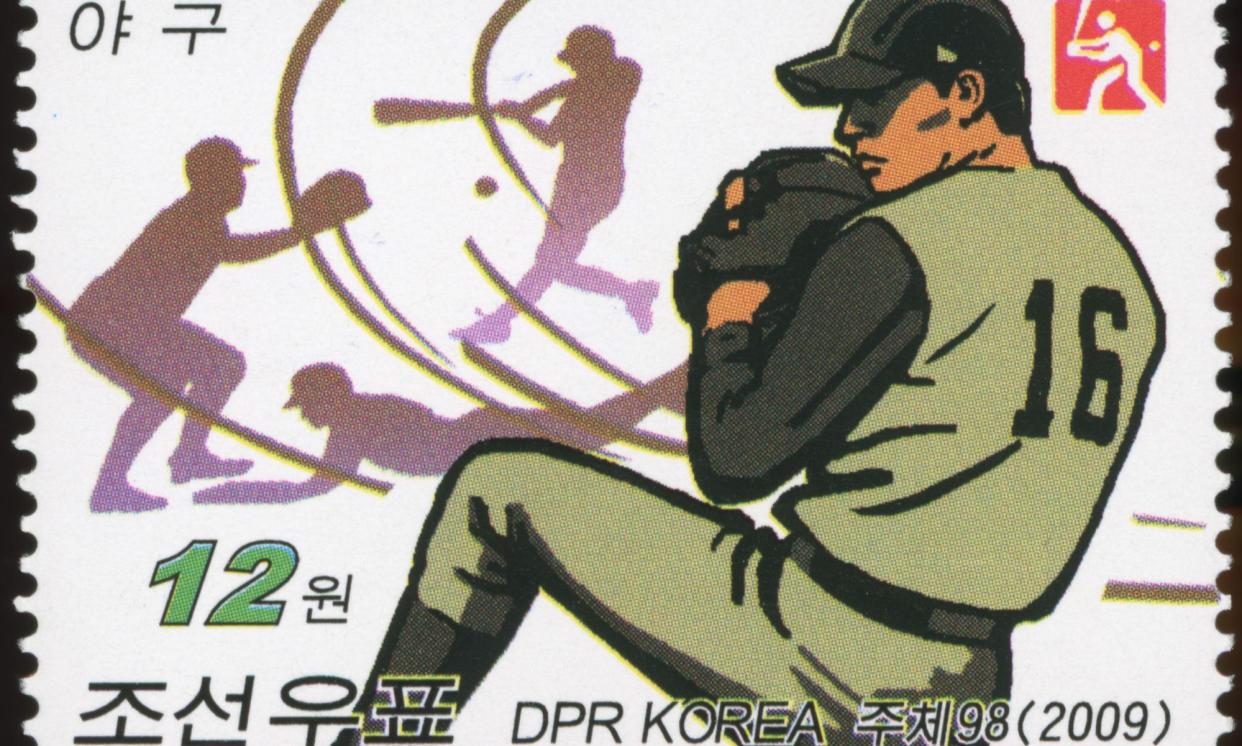Stamps, sticks and stories: looking for traces of baseball in North Korea

How do you find evidence that people are still playing – or still remember – a once-loved sport?
Earlier this year, when a baseball team called the Challengers, made up of young North Korean defectors, toured the US, American and Korean media reported that baseball was “unheard of” in the North.
But there are traces of baseball, that most American of sports, in schoolyard games, a dusty field with bases and a pitcher’s mound, and stories told by defectors to the South. James Banfill, a member of the American Society of Baseball research, says there is evidence that the game is still played in limited forms. Certainly it is still remembered in a country that has proclaimed itself America’s “biggest enemy”.
Related: North Korean table tennis players may be punished for Olympic podium selfie with rivals from South
Preserving baseball’s history – and present – is important, he says. Some day, North Koreans may be looking for clues about who they were, or what it meant to be Korean, before life under a dictatorship.
“If there’s some future North Korean baseball fan, they can look back at their own history and say, well, we did have history here, you know?”
Controlling people through culture
The first known game of baseball in Korea was in 1894, in Seoul, 50 years before the country’s division into North and South, and was likely spread to the north of the country by American missionaries, says Banfill. In 1913, one missionary wrote that the hardest part of organising games was convincing high school students to overcome their fear of playing catcher – northern Korean teenagers had a reputation for being skilled rock throwers.
By the 1920s, it was being played in schools, government ministries, businesses and the military. In the 1970s, decades after division, exhibition games were played in the North against the Cubans.
Kim Dong-Su, whose name has been changed to protect his identity, defected from the North in 2009, when he was a student. He works as a journalist in South Korea, and says that he first heard about baseball through his grandfather – but that before defecting, he had never seen a baseball ball.
When Kim was a child in the 1990s, he and his grandfather were watching a movie set in the 1930s, in which the Japanese antagonists wore strange gloves and carried wooden bats, which they used during street fights with Koreans. Korea was ruled by Japan as a colony from 1910 to 1945.
When Kim asked what the odd props were, his grandfather said: “We used to play that game back when I was younger, and I used to play it with the Japanese.”
Kim believes it is Japan’s love of baseball, not America’s, that is responsible for its current lack of popularity in the North.
“Japan is a worse enemy than America,” he says.
As children, if Kim and his friends were seen playing sports that resembled baseball, they would have been in a lot of trouble, Kim said, because of its associations with Japan.
“North Korea controls its people through its culture.”
‘A friendly country that enjoys a wide range of sports’
Banfill has spoken to people who have said it is still played in the military, and there are women’s softball teams – a game similar to baseball – who play on a dedicated softball field in Pyongyang.
The World Baseball Softball Confederation lists DPR Korea as a member of the organisation – a membership confirmed in an email to the Guardian.
And then there are the stamps, issued between 2000 and 2009, that depict baseball. But they aren’t necessarily proof. Banfill says they likely “reflect a wider interest in sports in general”. He points out that North Korea made stamps commemorating Diana Spencer’s marriage to Prince Charles in 1981.
Kim says that because the stamps were issued for the World Stamp expo, he thinks they were just part of North Korea’s efforts to present itself internationally as “a friendly country that enjoys a wide range of sports”.
Nobody his age plays baseball, he says, and there are many millennial and Gen-Z North Koreans who have never heard of it.
The game is also depicted in a North Korean film: Gwangju Calls Out. Released in 1985 and still aired today, it features a baseball game played between Japanese and Korean high schoolers.
“Both sides are supported by cheerleaders displaying their national costumes – kimonos for Japanese and hanbok for Koreans,” Banfill writes. “The game is politicised when a Japanese official asks the home plate umpire to call a play in favour of the Japanese.”
It is also played in an episode of the long-running North Korean cartoon Clever Raccoon Dogs and, again, has a political message: the match is between a team of small animals – much like the small but mighty image North Korea’s regime seeks to project – and a team made up of large ones. It’s cats, dogs, turtles and pigs versus elephants, rhinos and giraffes.
Banfill is not the first to find evidence that some people in the North are preserving the game in one way or another. In 2017, Curtis Melvin, a researcher at Johns Hopkins University, noticed a dusty diamond-shaped field with four bases and a pitcher’s mound on satellite imagery – and it seemed to have been recently used, he told the Wall Street Journal, which reported that baseball teams have been shown on television competing in North Korea’s northern city of Nampo as recently as 2014.
Lee Hae-young, who left North Korea for the South in 1996, told the WSJ that he remembered playing a baseball-like game as a child, using a wooden stick or tree branch. It was called “bba-ru” – a name that sounds like American baseball legend Babe Ruth.


